The Daily Shot: 24-Sep-20
• Equities
• Rates
• Commodities
• Energy
• Emerging Markets
• Asia – Pacific
• The Eurozone
• The United Kingdom
• The United States
• Global Developments
• Food for Thought
Equities
1. It’s been a rough month for stocks.
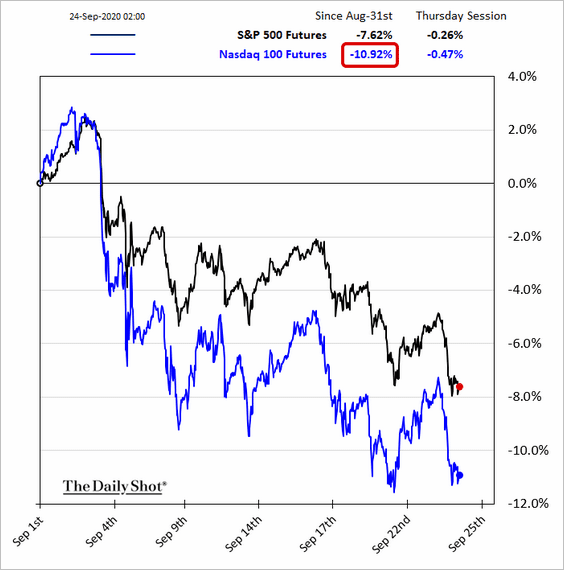
Let’s take a look at a few reasons for the US market jitters.
• There are some concerns about lockdowns returning.
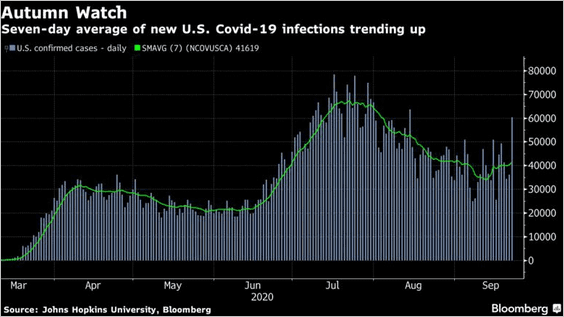 Source: @business Read full article
Source: @business Read full article
• The rising US dollar is generally not great for risk assets, including equities.
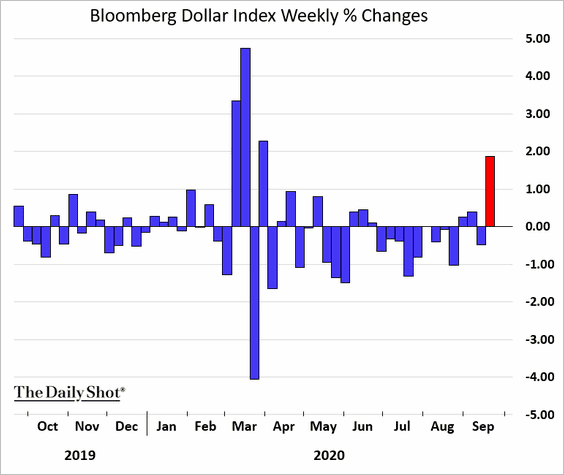
• Potential regulatory action is spooking tech investors.
 Source: Reuters Read full article
Source: Reuters Read full article
• Rising political uncertainty is on the minds of some investors.
 Source: Commerzbank Research
Source: Commerzbank Research
 Source: Twitter
Source: Twitter
This risk is increasingly being priced into the options markets. Here is the VIX futures curve.
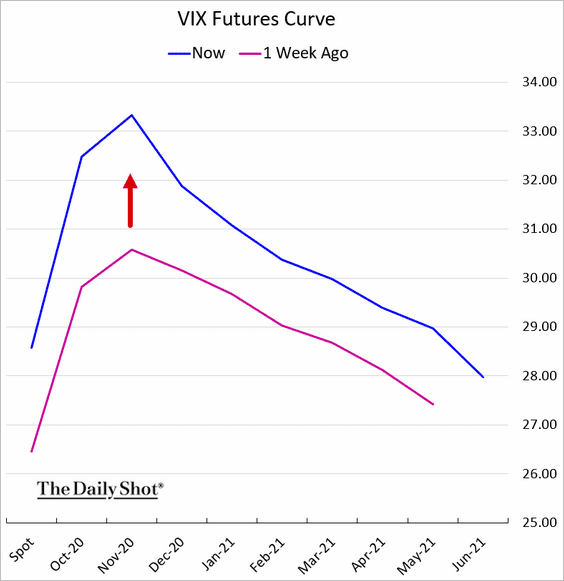
Currency markets are also pricing in the US political risk. Here is the spread between the two- and the one-month USD/JPY implied volatility.
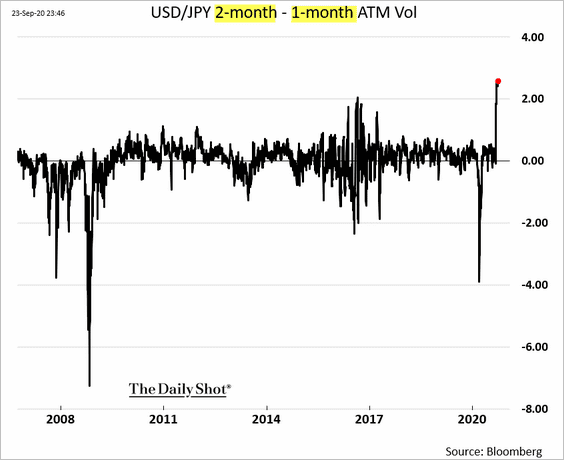
• Moreover, the risk of higher taxes ahead is pressuring stocks, boosted by expectations that Democrats could flip the Senate.
 Source: The Economist Read full article
Source: The Economist Read full article
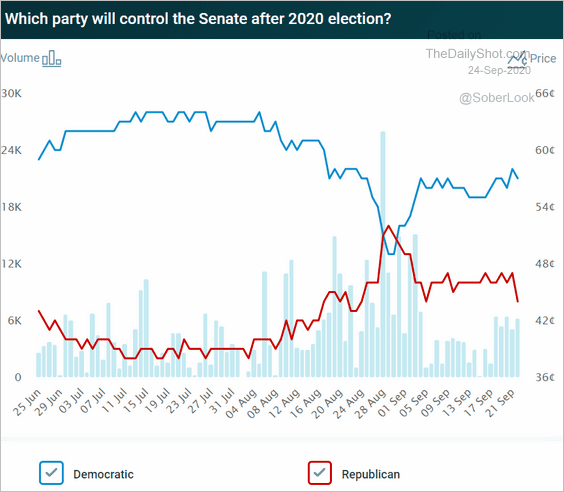 Source: @PredictIt
Source: @PredictIt
Tax increases could be substantial.
 Source: CNBC Read full article
Source: CNBC Read full article
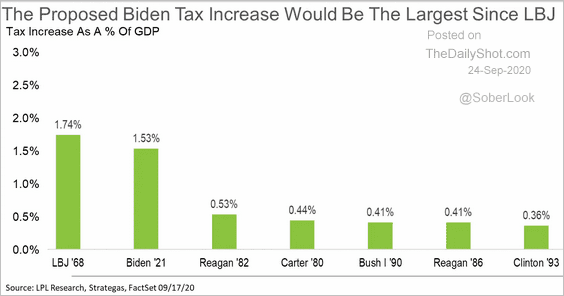 Source: LPL Research
Source: LPL Research
On the whole, Biden’s current proposals point to a net fiscal expansion (spending exceeding tax increases).
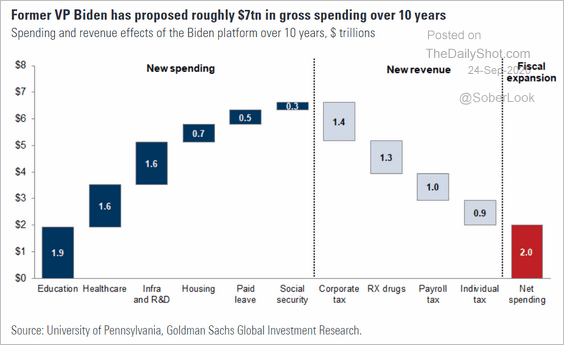 Source: Goldman Sachs
Source: Goldman Sachs
——————–
2. Share buyback activity is running well below the levels we’ve seen in recent years. Companies known for buying their stock have been underperforming (second chart).
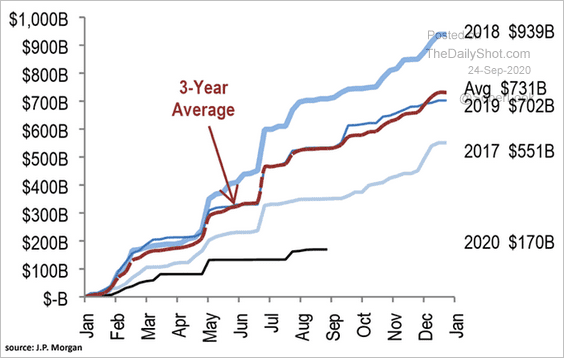 Source: @ISABELNET_SA, @jpmorgan
Source: @ISABELNET_SA, @jpmorgan
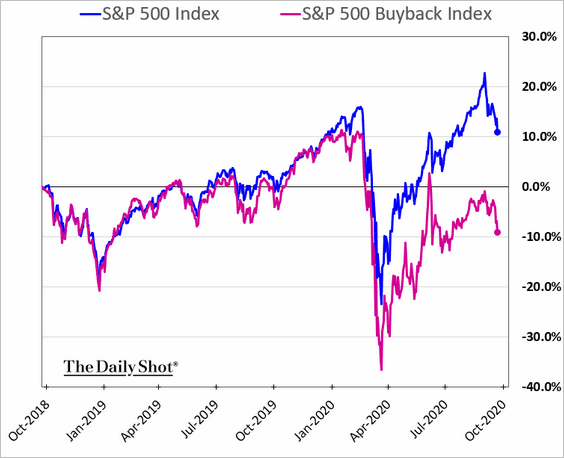
——————–
3. Stocks perceived to be less exposed to the virus continued to outperform (2 charts).
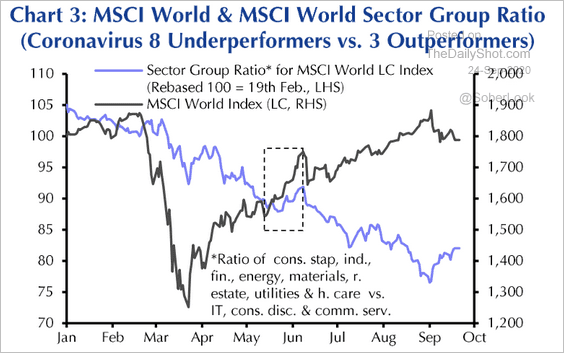 Source: Capital Economics
Source: Capital Economics
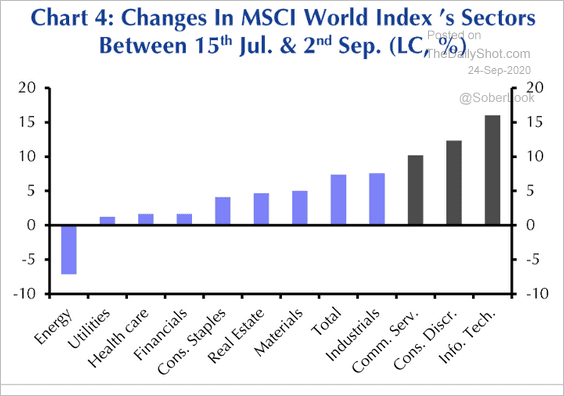 Source: Capital Economics
Source: Capital Economics
——————–
4. Here are some sector performance charts.
• Banks:
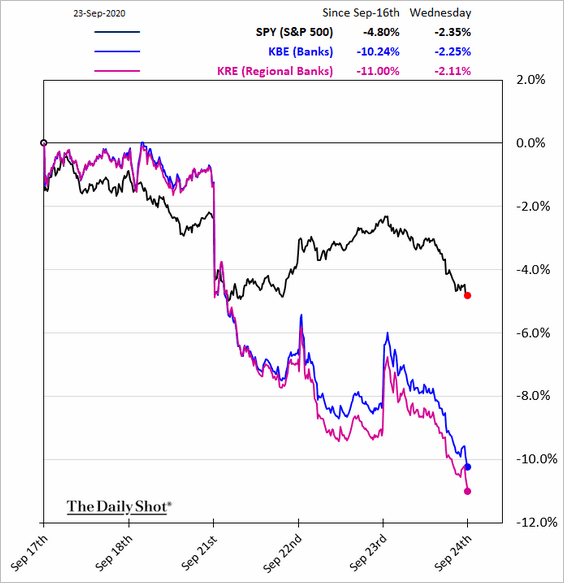
• Consumer Discretionary:
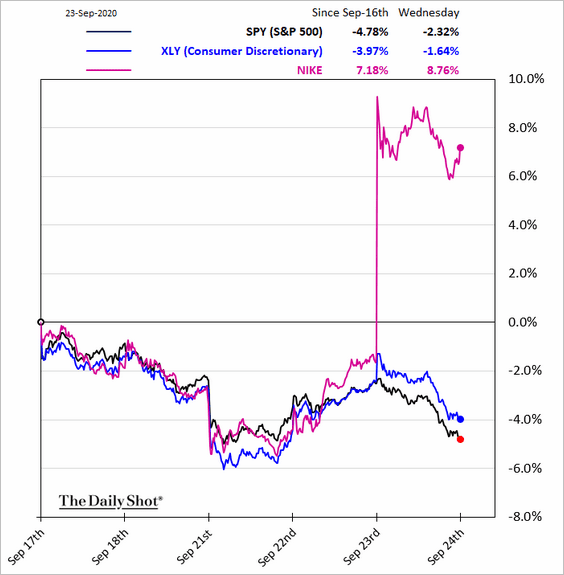
• Healthcare:
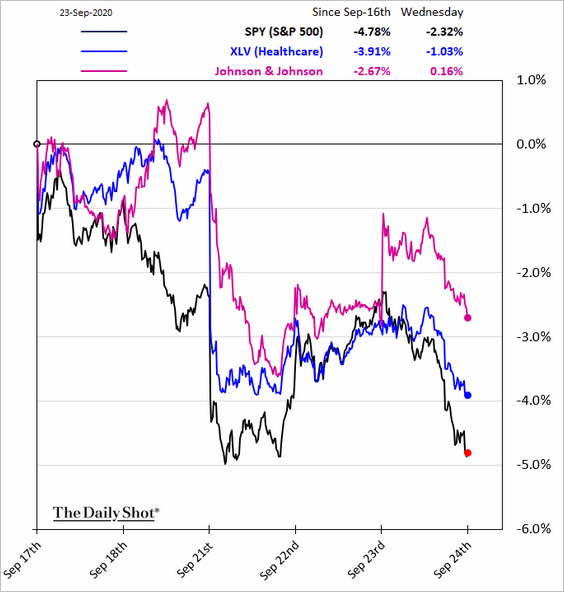
• Homebuilders:
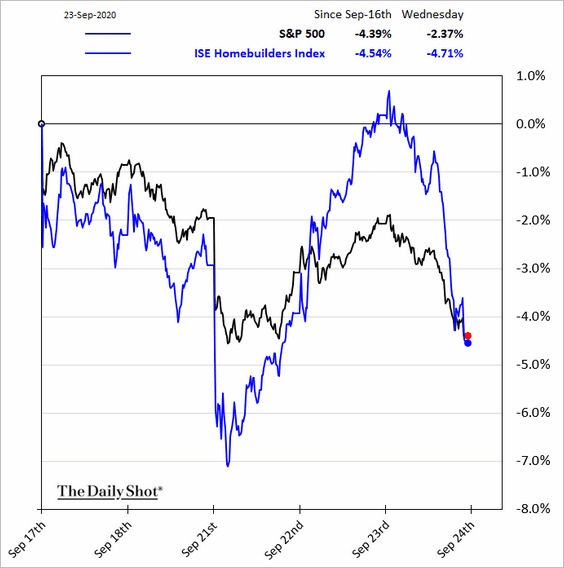
• Tech:
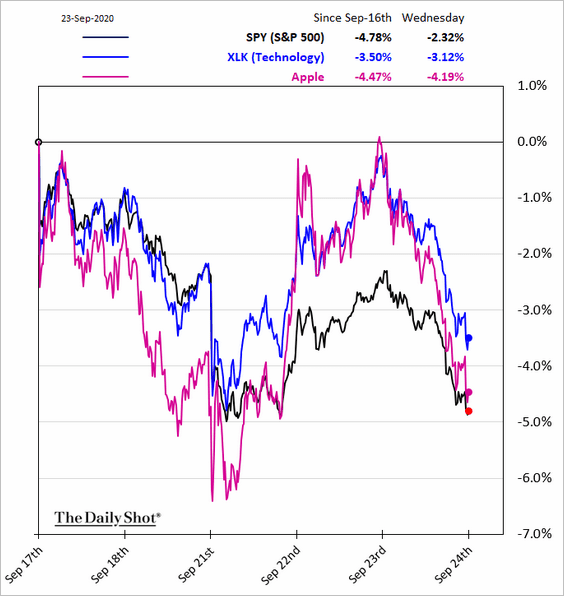
• Metals & Mining:
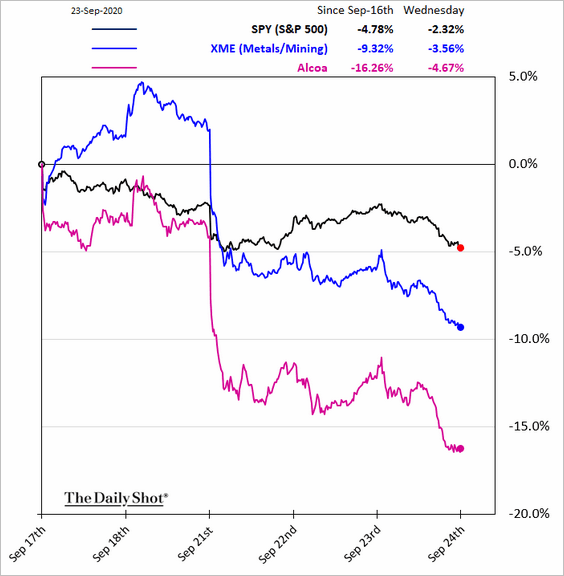
• Energy:
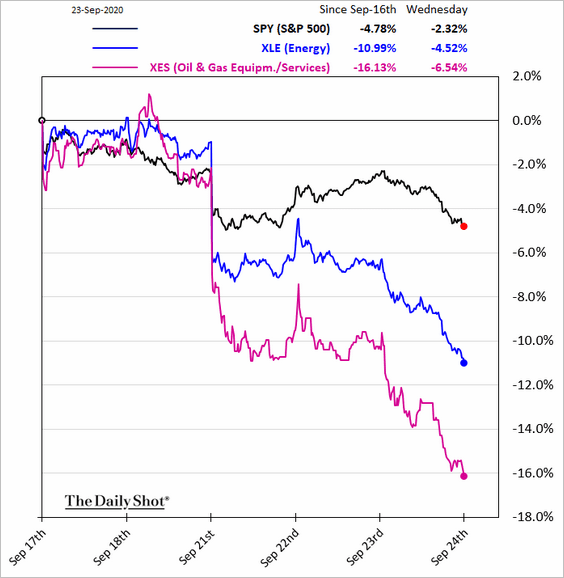
——————–
5. Small caps are underperforming again.
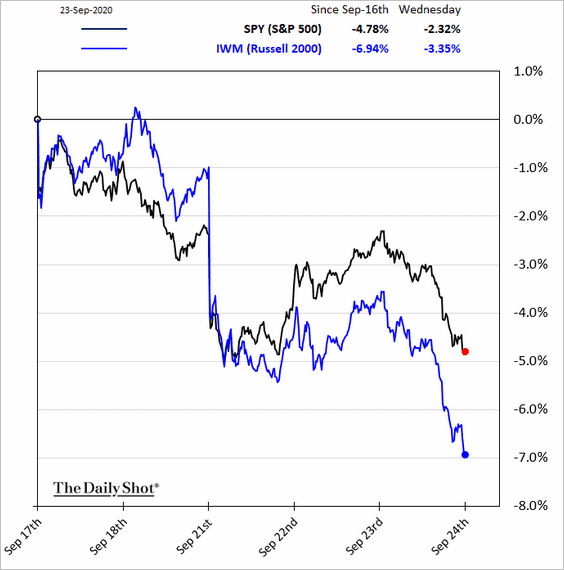
6. Shares of firms known for dividend growth have been more stable.
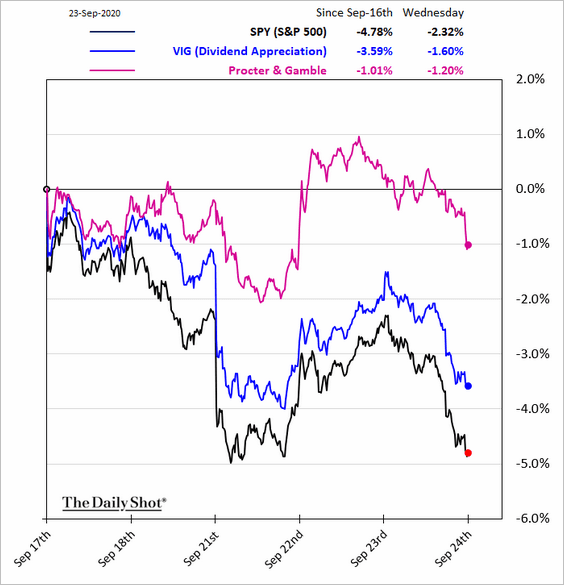
7. The S&P 500 correlation to smaller stocks is recovering.
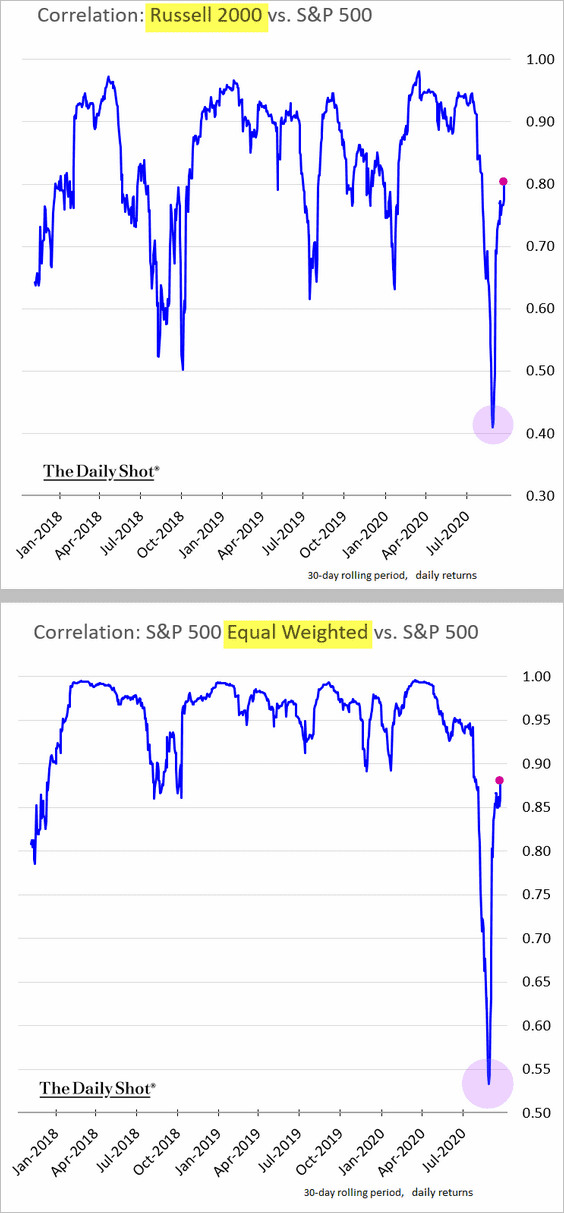
Rates
1. TIPs continue to see record inflows, amassing $10.3 billion over the past 3 months.
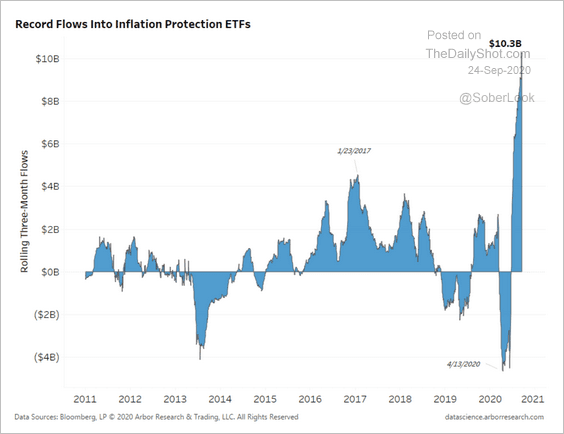 Source: Arbor Research & Trading
Source: Arbor Research & Trading
2. What would it take for rates to rise?
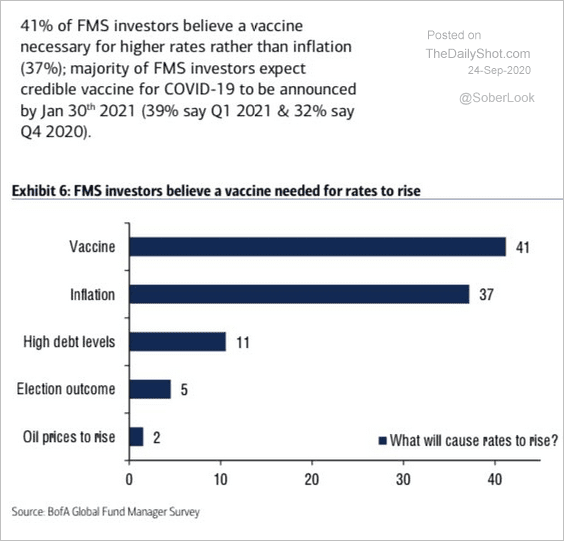 Source: BofA Securities, @WallStJesus
Source: BofA Securities, @WallStJesus
3. Declining inflation volatility has been pushing down the 10-year Treasury term premium for several decades.
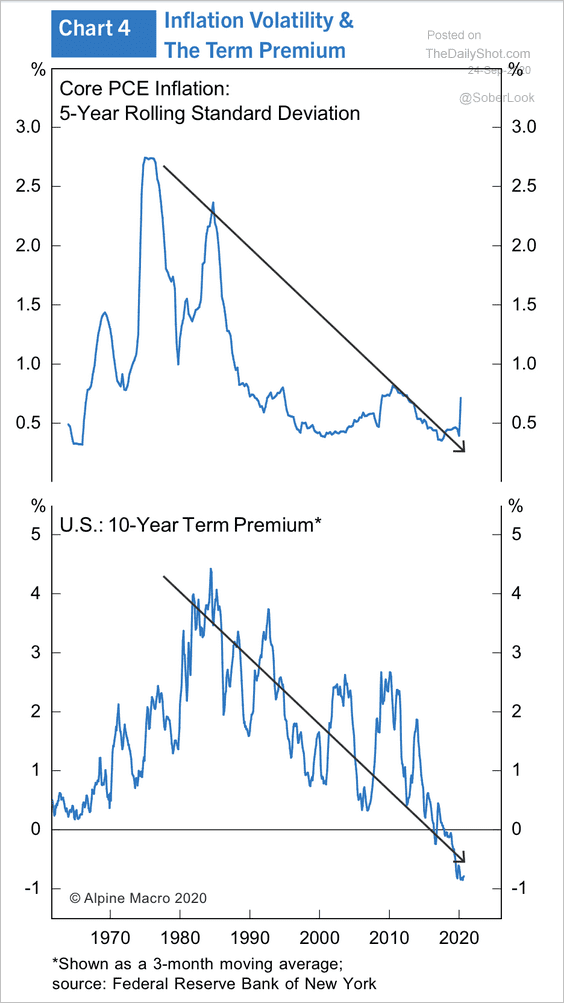 Source: Alpine Macro
Source: Alpine Macro
Commodities
1. It’s been a challenging month for precious metals.
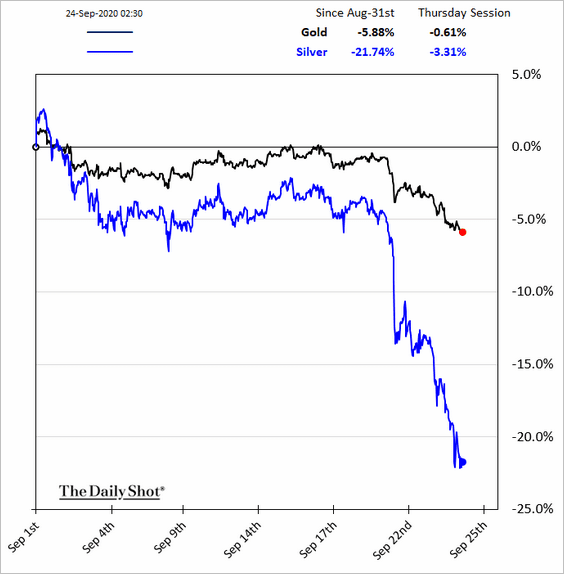
2. The pandemic boosted tea prices.
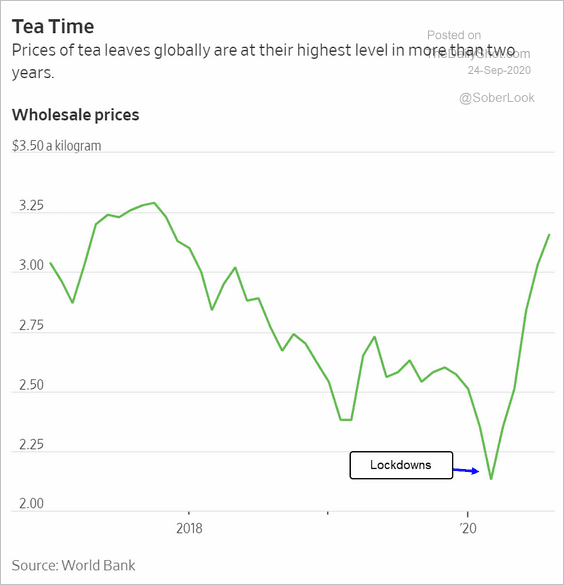 Source: @WSJ Read full article
Source: @WSJ Read full article
Energy
1. US natural gas prices came roaring back after the recent collapse and are now up over 25% from the lows.
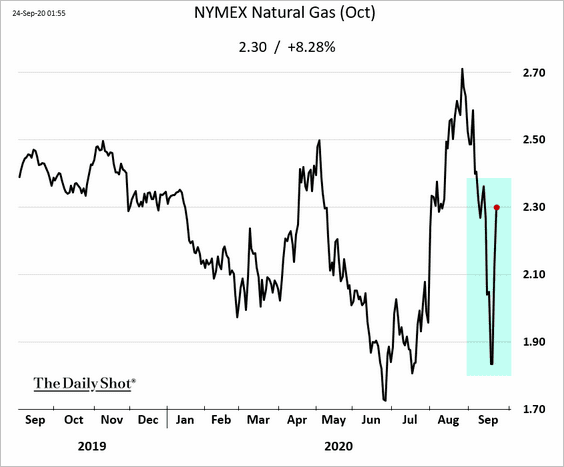
A forecast for cold weather in the eastern US was the catalyst for this reversal (heating demand).
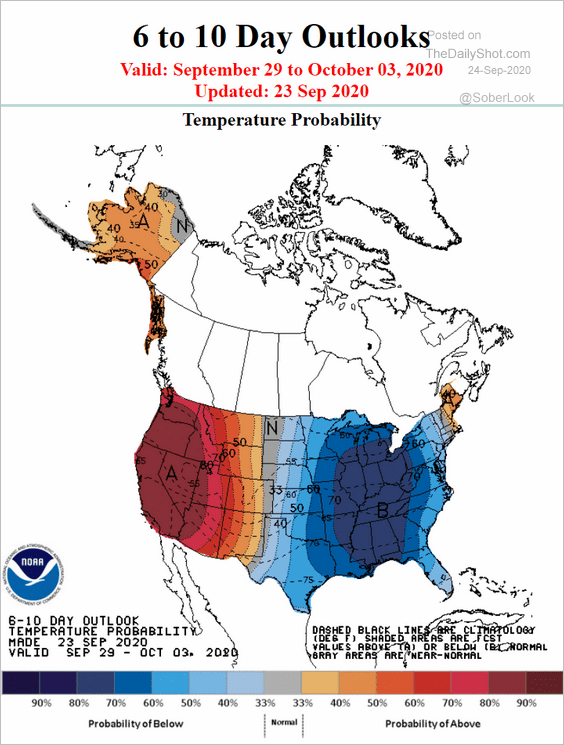 Source: NOAA
Source: NOAA
Natural gas implied volatility is at the highest level in at least a decade.
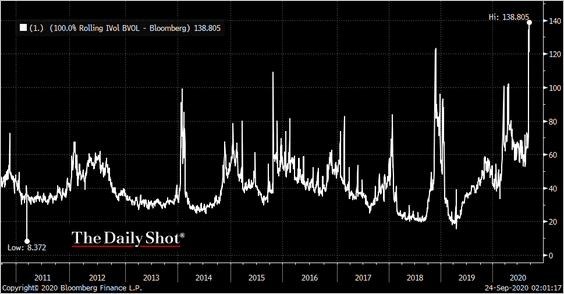 Source: @TheTerminal, Bloomberg Finance L.P.
Source: @TheTerminal, Bloomberg Finance L.P.
——————–
2. US crude oil production remains depressed.
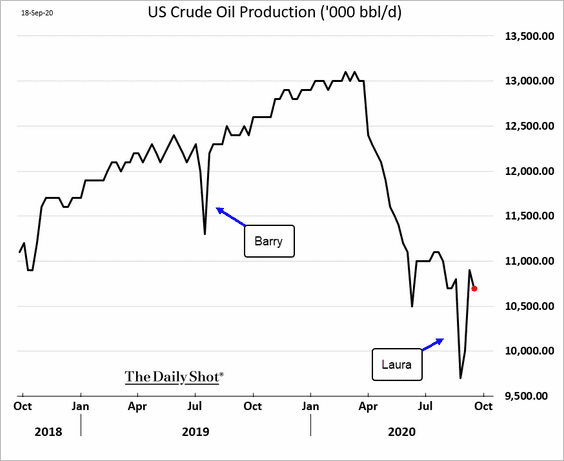
3. Here is the implied US gasoline demand.
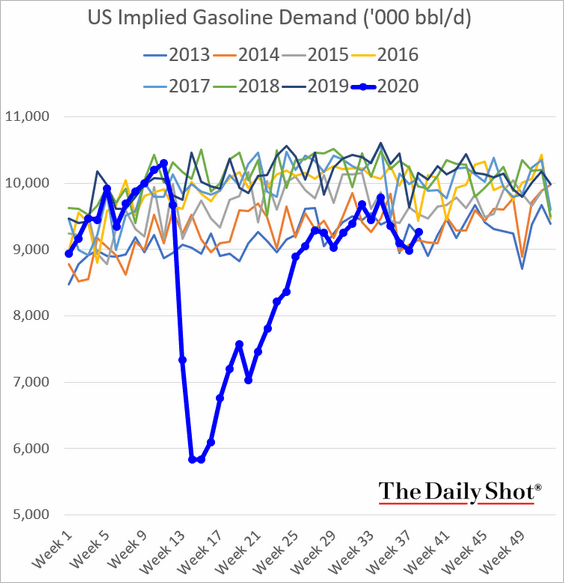
Gasoline inventories have been declining (absolute levels shown).
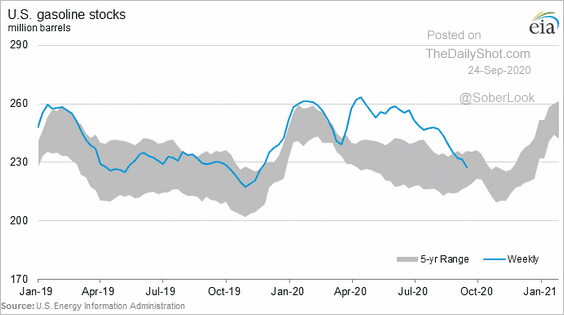
Emerging Markets
1. EM currencies sold off amid increased risk aversion.
• The Mexican peso:
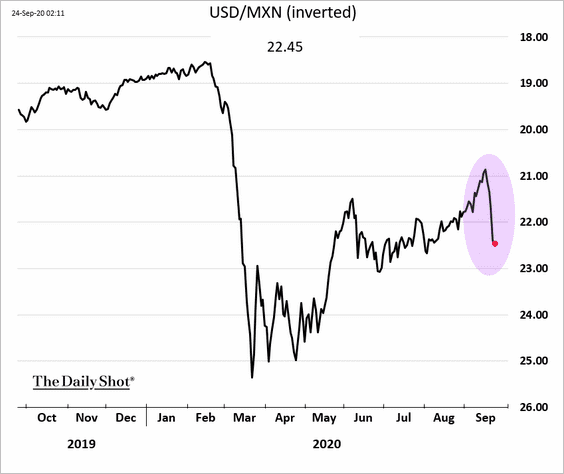
• The JP Morgan EM Currency Index:
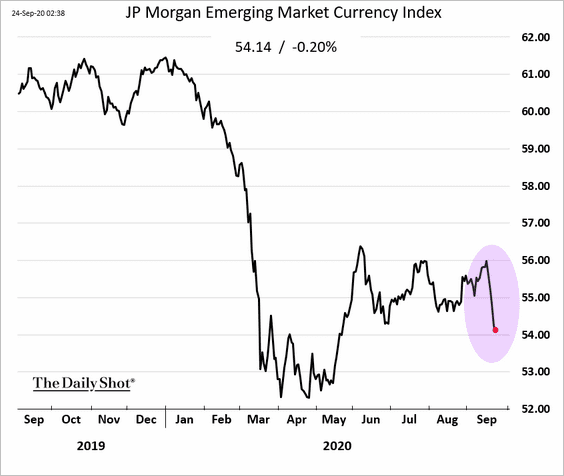
——————–
2. Here are some updates on Mexico.
• Retail sales (through July):
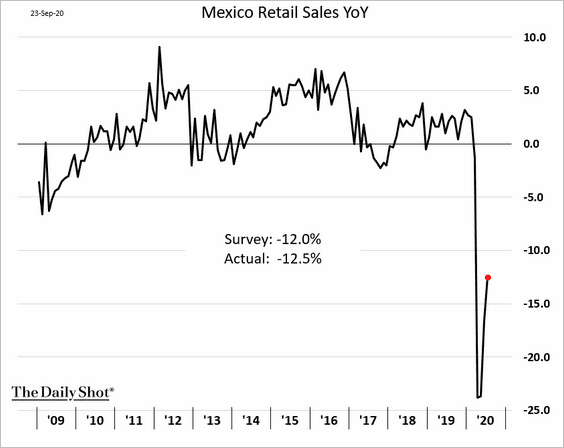
• Retail sales vs. remittances:
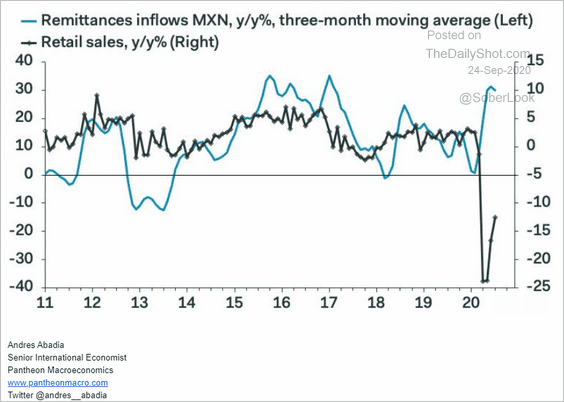 Source: Pantheon Macroeconomics
Source: Pantheon Macroeconomics
• Food CPI and inflation expectations:
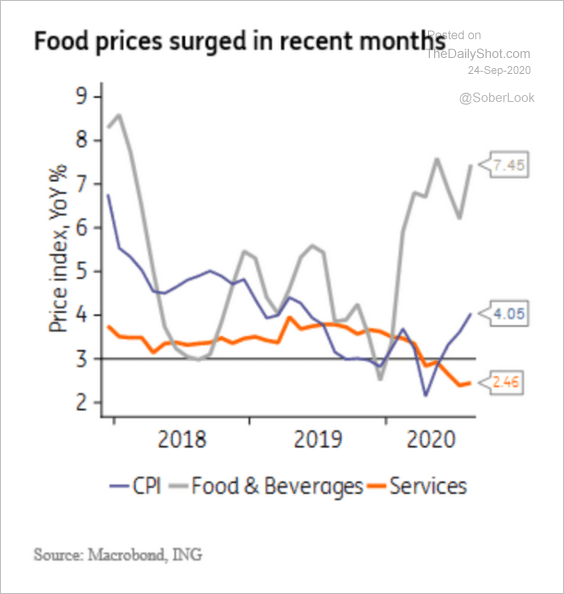 Source: ING
Source: ING
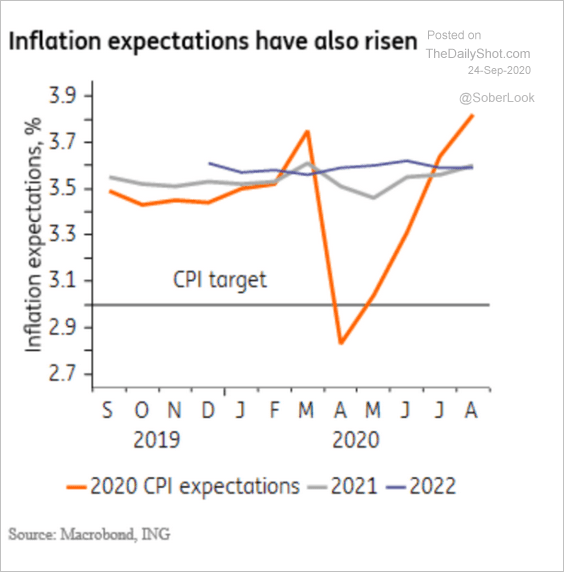 Source: ING
Source: ING
• Deutsche Bank’s forecasts for Mexico vs. Brazil:
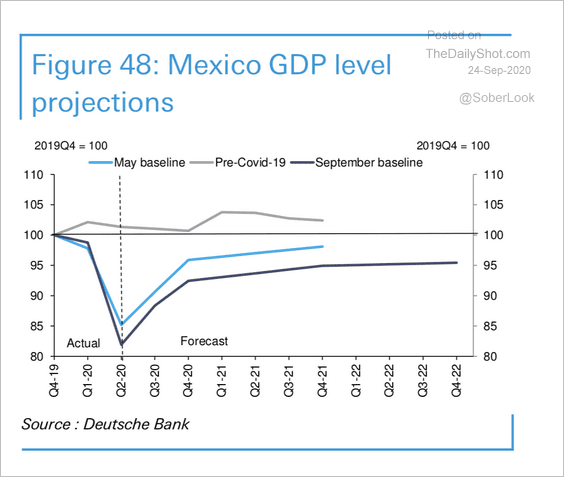 Source: Deutsche Bank Research
Source: Deutsche Bank Research
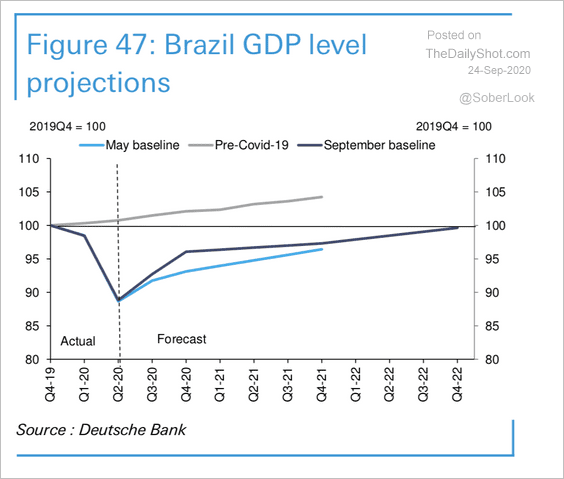 Source: Deutsche Bank Research
Source: Deutsche Bank Research
——————–
3. Colombia’s sentiment indicators are recovering.
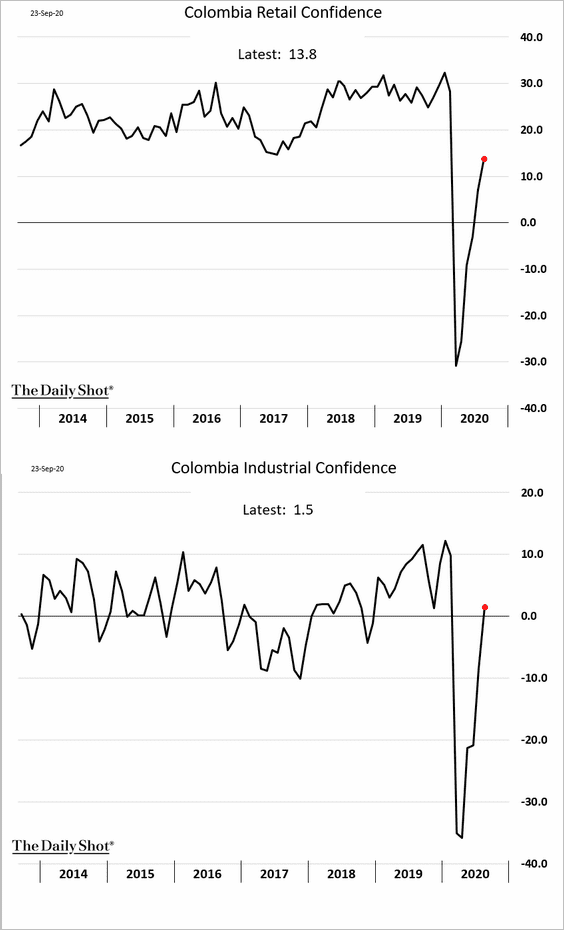
Asia – Pacific
1. Has Singapore’s inflation bottomed?
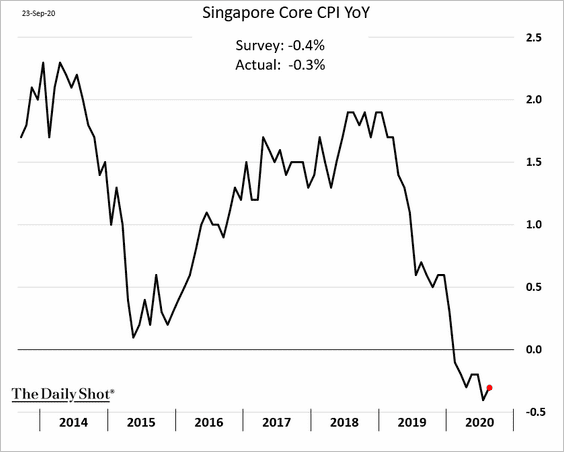
2. Markets are pricing in a chance that the RBNZ cuts rates ahead of its 12-month forward guidance ending March 2021, according to Morgan Stanley.
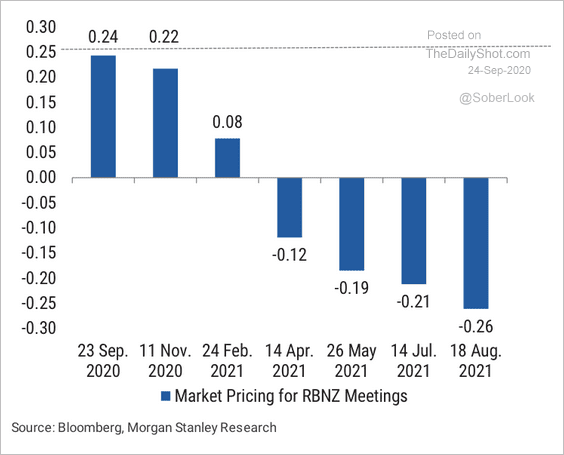 Source: Morgan Stanley Research
Source: Morgan Stanley Research
The growth of the RBNZ’s balance sheet relative to the RBA could support a higher AUD/NZD cross rate.
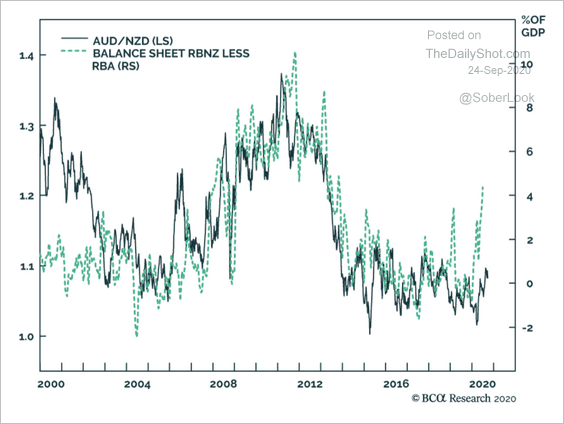 Source: BCA Research
Source: BCA Research
——————–
3. The Aussie dollar suffered its largest decline since mid-June.
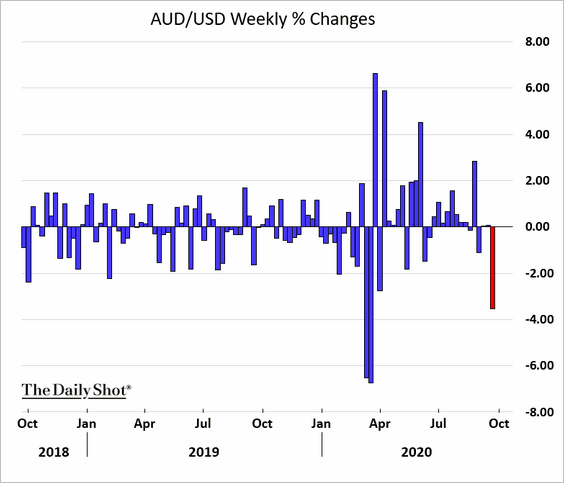
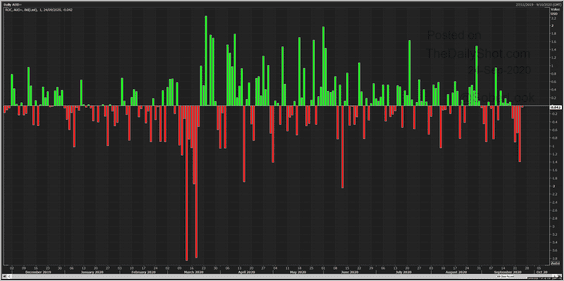 Source: @Scutty
Source: @Scutty
Australia’s 5yr yield dipped below 0.3%.
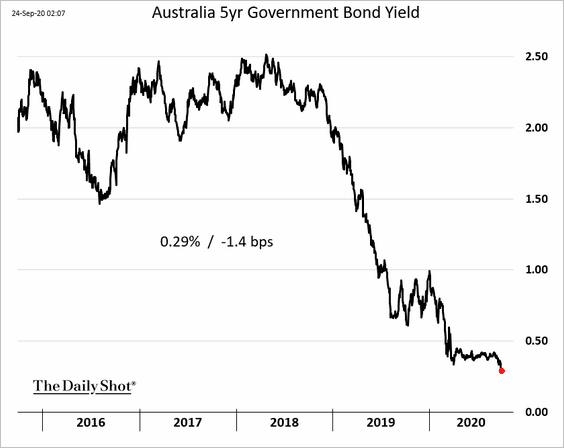
The Eurozone
1. The second wave of the pandemic is pressuring the service sector, while factory activity remains robust.
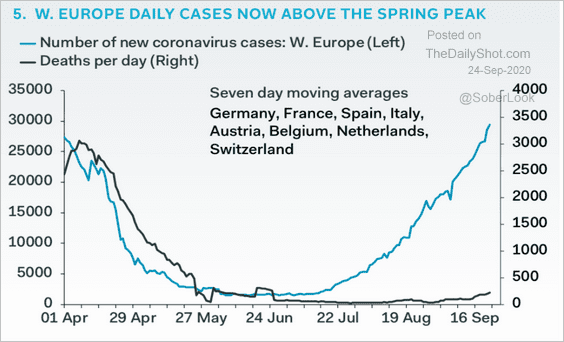 Source: Pantheon Macroeconomics
Source: Pantheon Macroeconomics
• September manufacturing PMIs for Germany and France (preliminary):
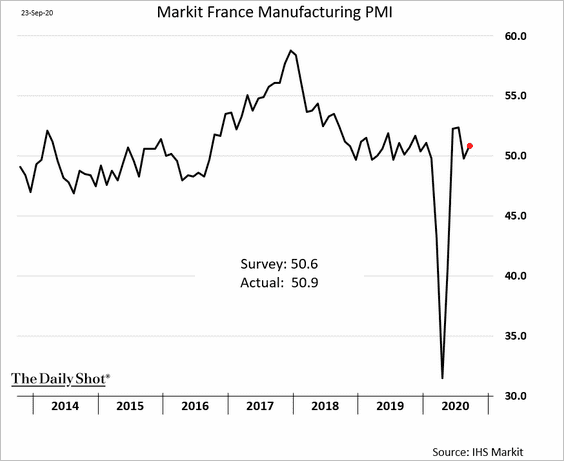
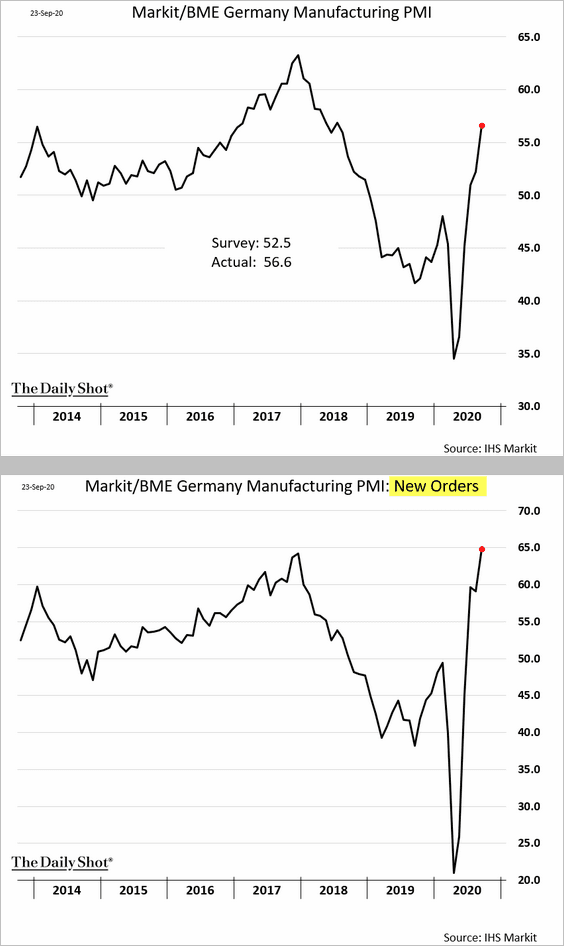
• Services PMIs:
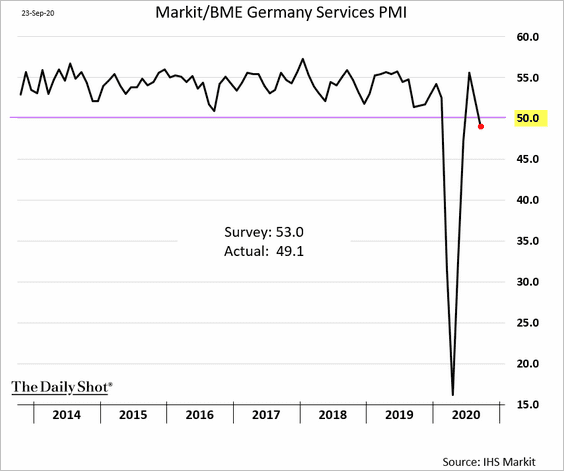
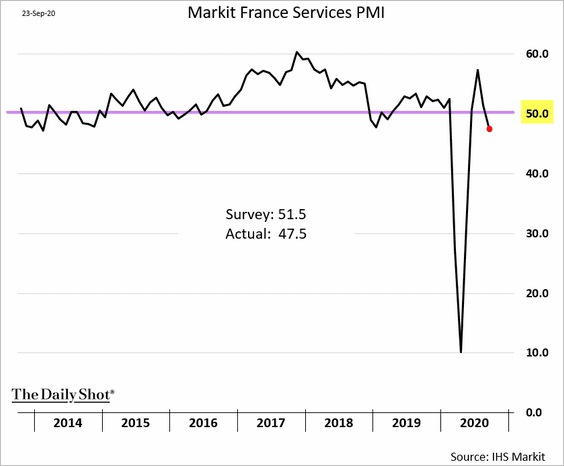
• The PMI at the Eurozone level:
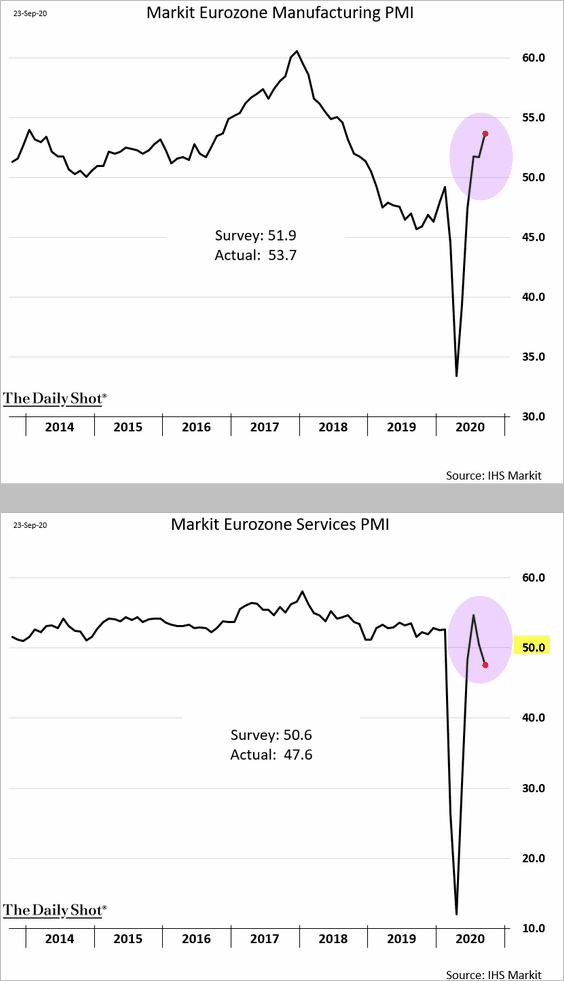
2. French manufacturing employment remains soft.
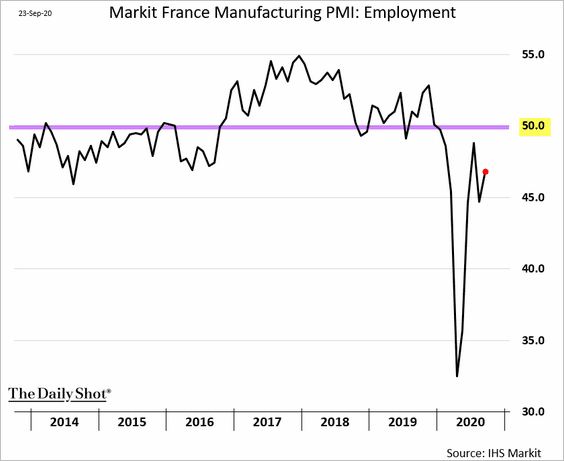
3. The recovery in Germany’s consumer sentiment has stalled.
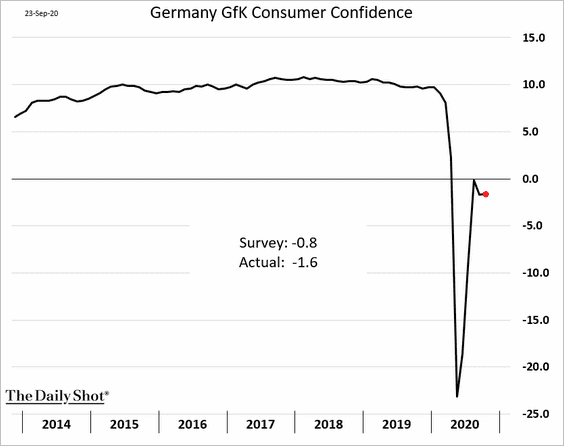
4. Italy’s 30yr bond yield hit a record low.
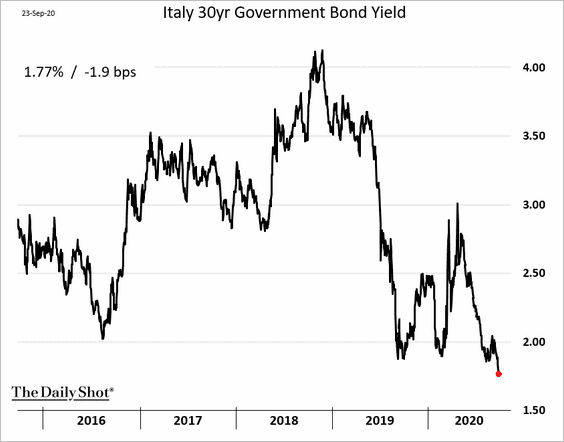
The latest rally was driven by the referendum results. Italy is also benefitting from much lower infection rates in the second wave.
• Mask-wearing:
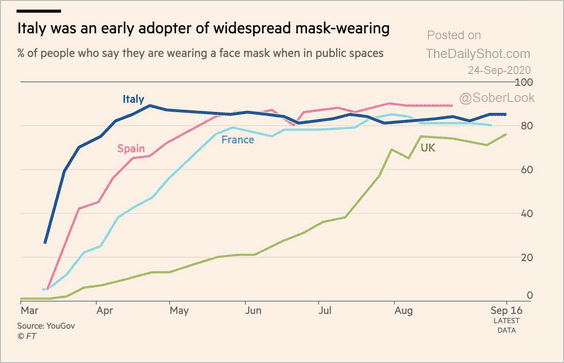 Source: @financialtimes Read full article
Source: @financialtimes Read full article
• Positive cases from tests:
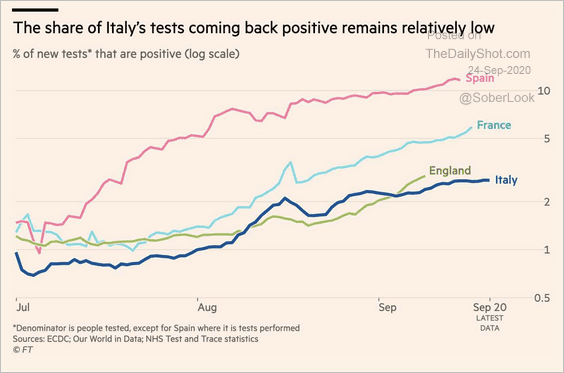 Source: @financialtimes Read full article
Source: @financialtimes Read full article
• New cases:
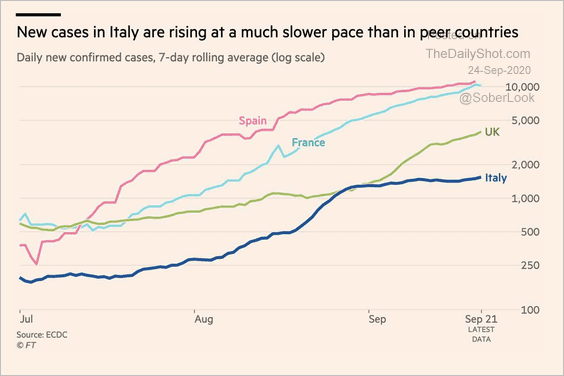 Source: @financialtimes Read full article
Source: @financialtimes Read full article
The United Kingdom
1. The Markit PMI report showed that business activity remained resilient this month (PMI well above 50).
• Manufacturing:
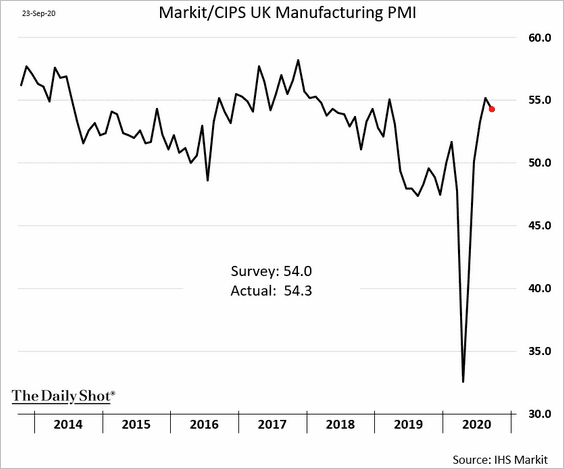
• Services:
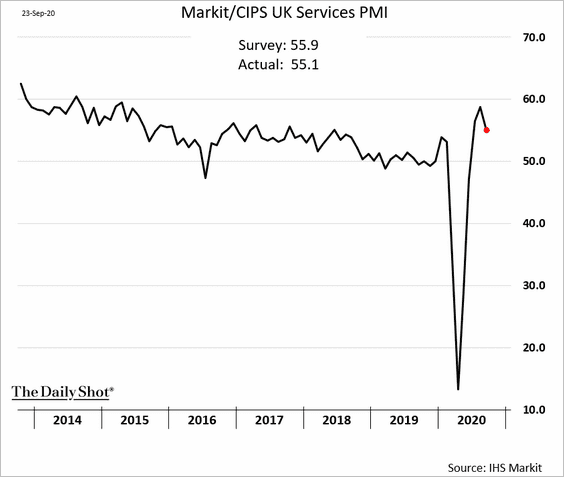
——————–
2. The UK has a lot of wealthy immigrants.
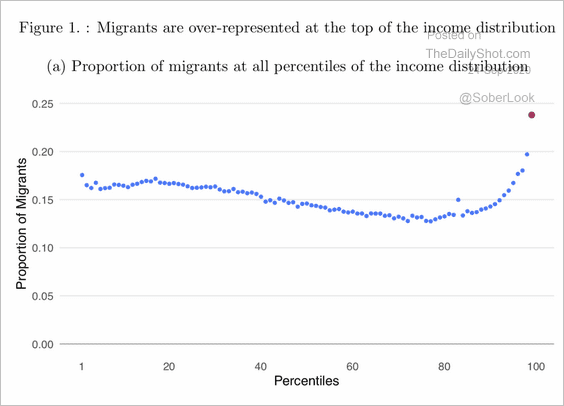 Source: CAGE Read full article
Source: CAGE Read full article
The United States
1. The Markit PMI report showed stable growth in business activity (PMI > 50).
• Manufacturing:
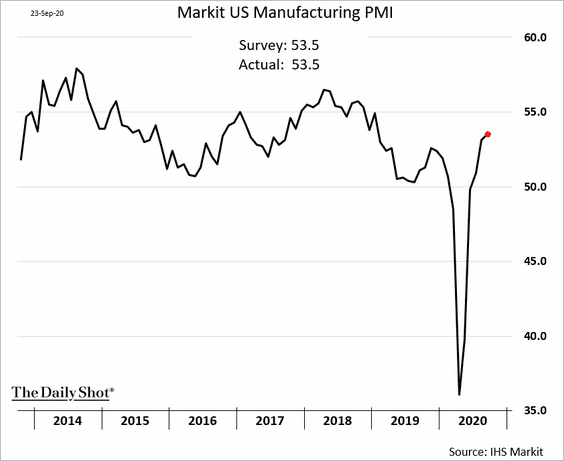
• Services:
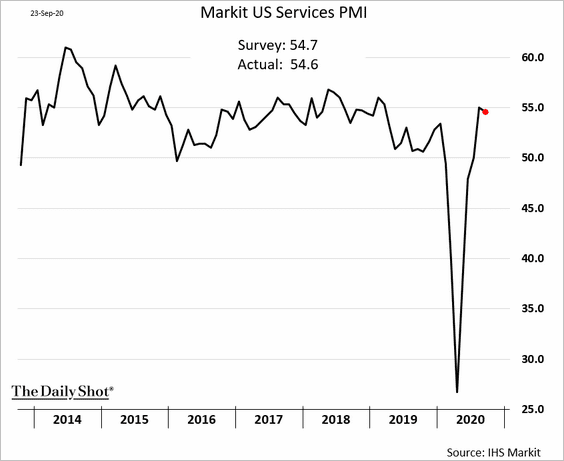
But service firms are becoming less upbeat.
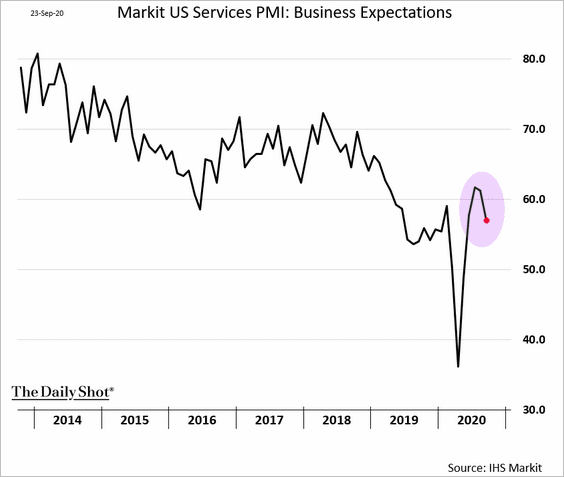
——————–
2. Mortgage applications for house purchase remain elevated.
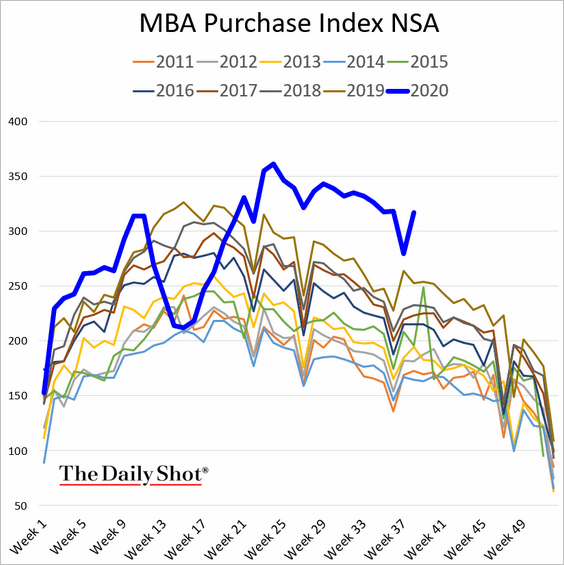
Homes are selling briskly, with fewer sellers willing to drop prices.
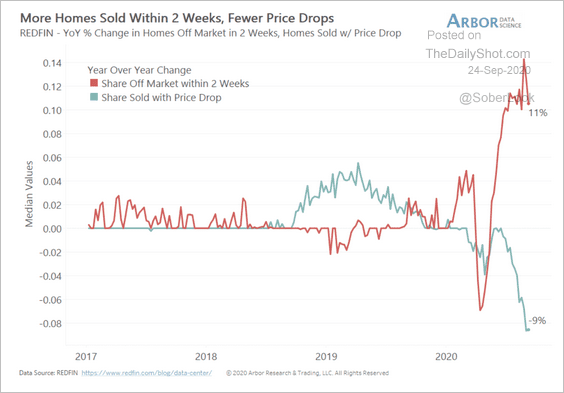 Source: Arbor Research & Trading
Source: Arbor Research & Trading
And home price appreciation has rebounded.
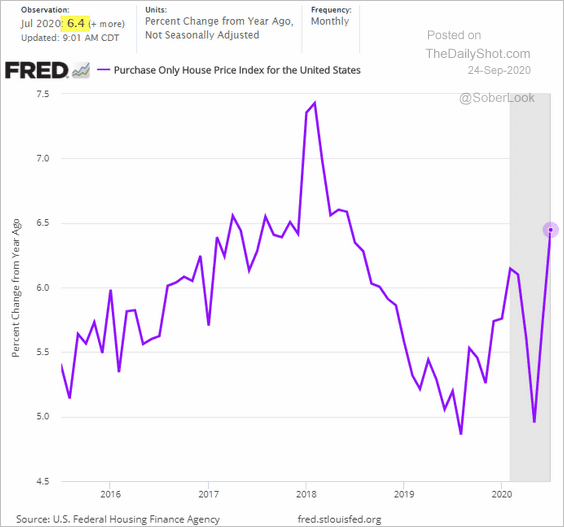
——————–
3. Next, we have some updates on the labor market.
• Job growth by skill level over the past three decades:
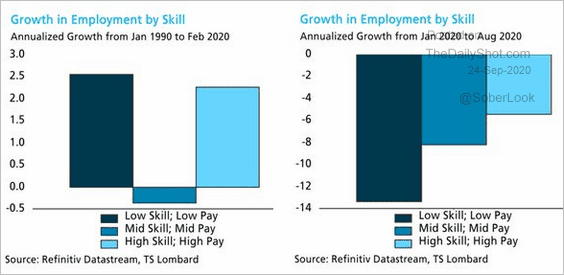 Source: @LizAnnSonders, @TS_Lombard, @Refinitiv
Source: @LizAnnSonders, @TS_Lombard, @Refinitiv
• Job status and income expectations:
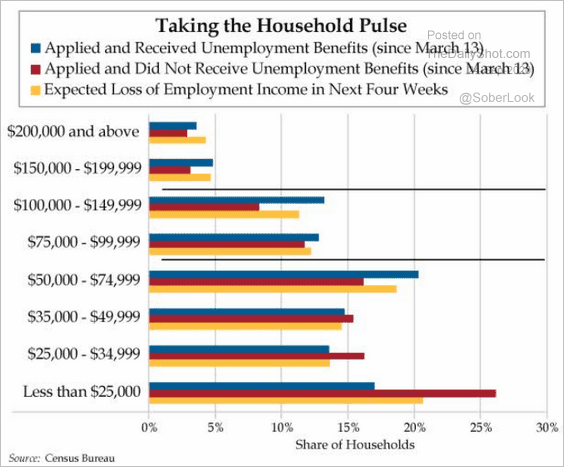 Source: The Daily Feather
Source: The Daily Feather
• Job postings by wage tier:
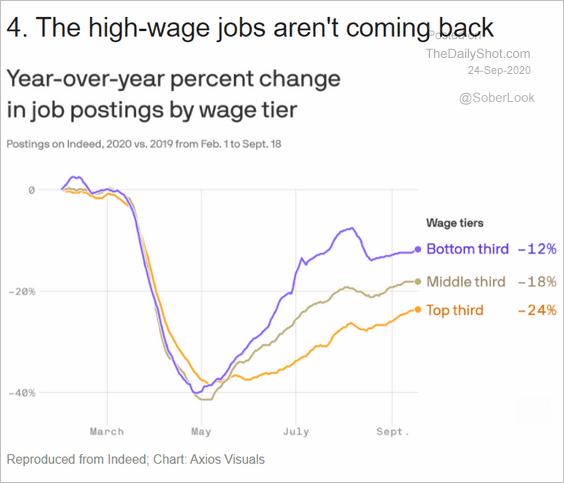 Source: @axios Read full article
Source: @axios Read full article
4. The US personal savings rate has been increasing since 2005, and recently surged due to government stimulus.
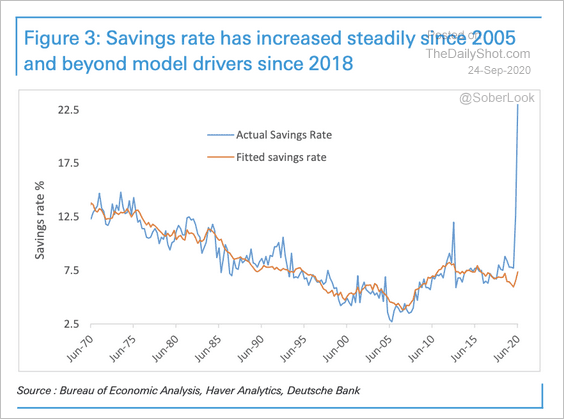 Source: Deutsche Bank Research
Source: Deutsche Bank Research
Global Developments
1. Global trade is rebounding.
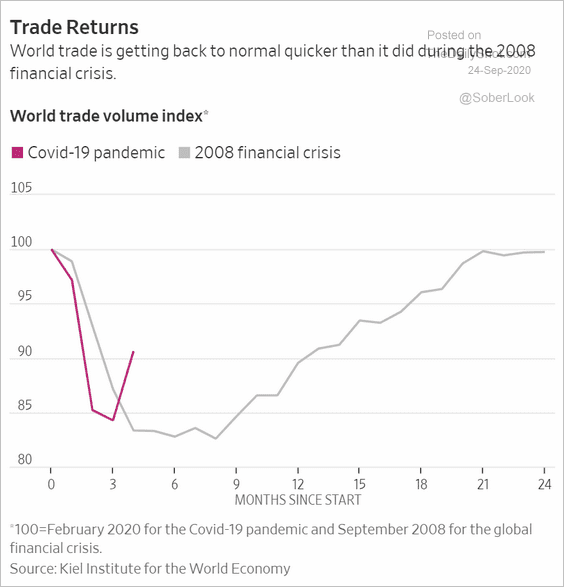 Source: @WSJ Read full article
Source: @WSJ Read full article
Here is BlackRock’s real-time trade indicator.
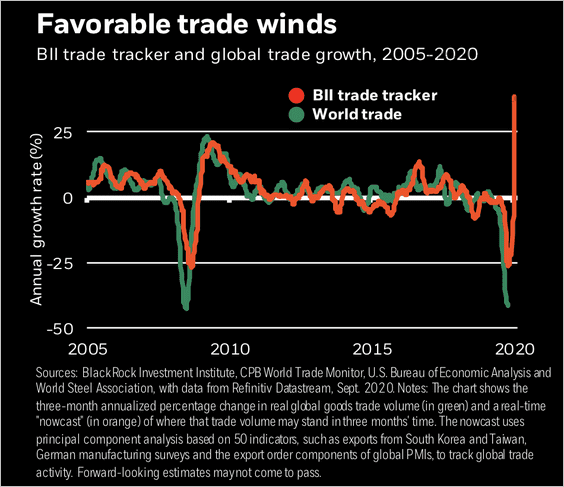 Source: BlackRock
Source: BlackRock
——————–
2. Advanced economies will need some time to fully recover from the global recession, according to Barclays.
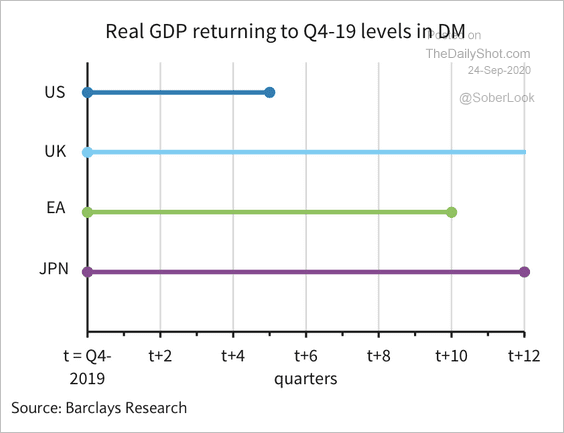 Source: Barclays Research
Source: Barclays Research
3. Early-cycle or recession?
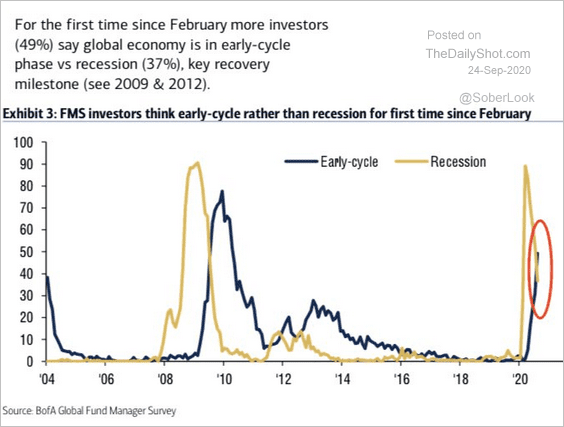 Source: BofA Securities, @WallStJesus
Source: BofA Securities, @WallStJesus
——————–
Food for Thought
1. Changes in working hours since 1870:
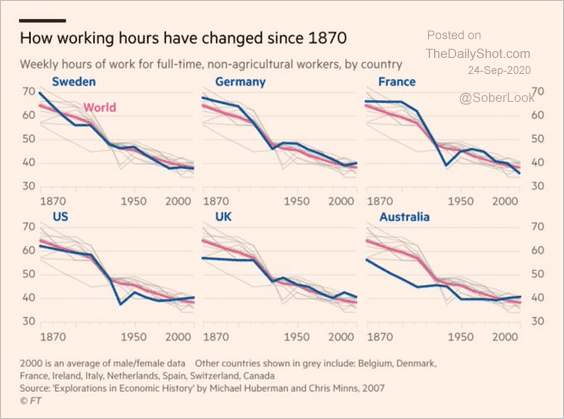 Source: @adam_tooze, @FT Read full article
Source: @adam_tooze, @FT Read full article
2. Labor force participation among young US women:
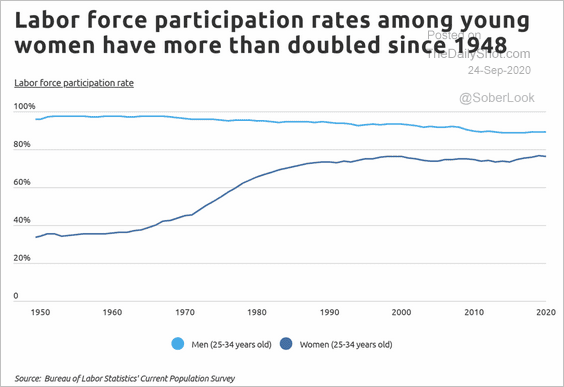 Source: Self Read full article
Source: Self Read full article
3. Average US commute time:
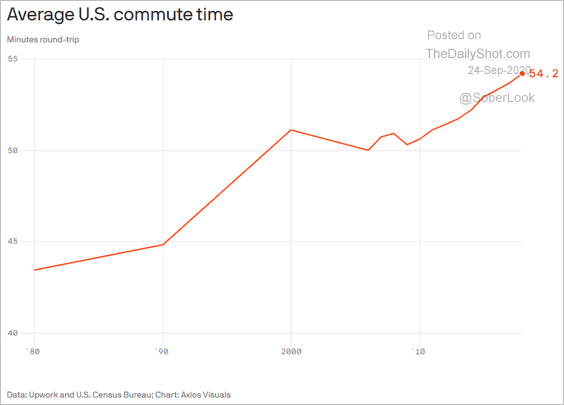 Source: @axios Read full article
Source: @axios Read full article
4. Zoom Video revenues:
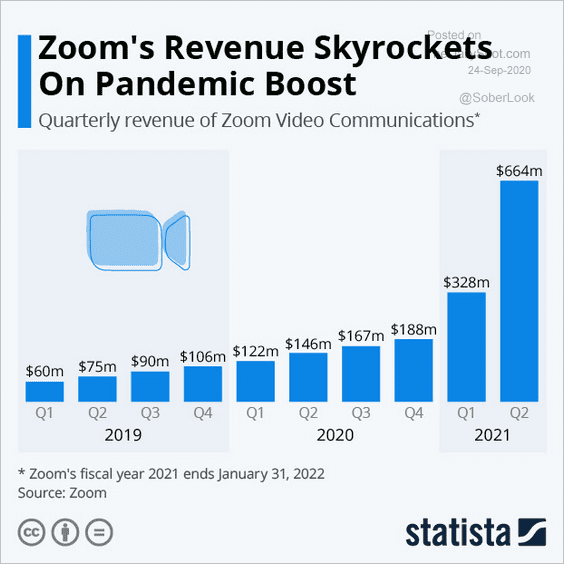 Source: Statista
Source: Statista
5. Americans’ views on news organizations:
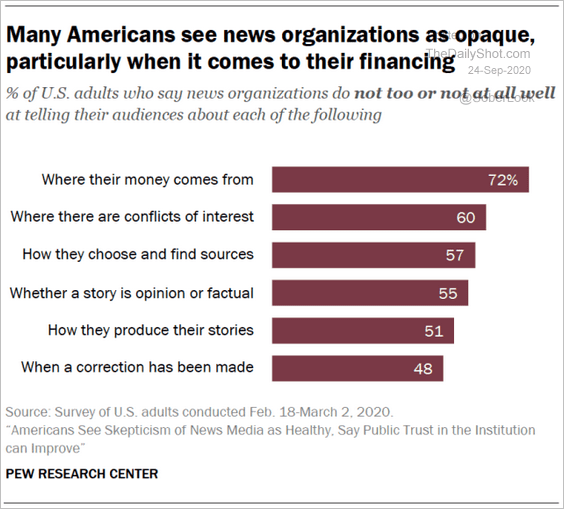 Source: @gottfriedjeff, @pewresearch Read full article
Source: @gottfriedjeff, @pewresearch Read full article
6. US Electoral College projections:
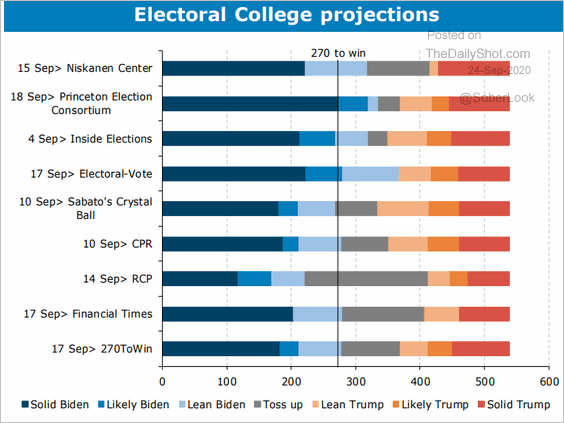 Source: ANZ Research
Source: ANZ Research
7. Satisfaction with safety conditions at work:
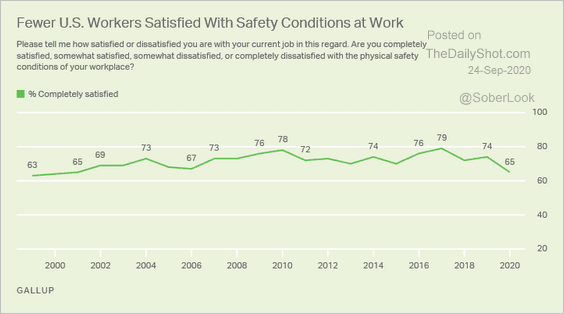 Source: @GallupNews Read full article
Source: @GallupNews Read full article
8. Population changes in US jails:
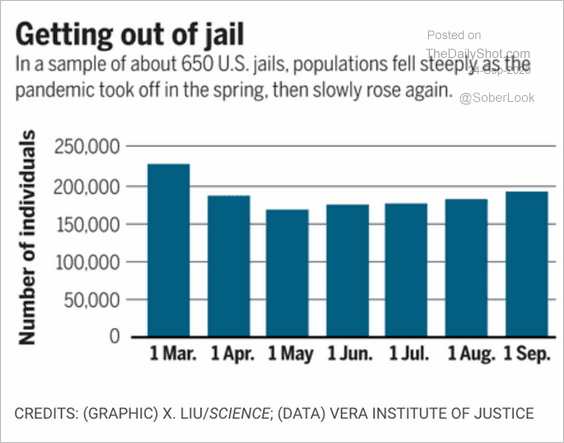 Source: @adam_tooze, @KellyServick Read full article
Source: @adam_tooze, @KellyServick Read full article
9. Visibility in the dark:
 Source: @simongerman600 Read full article
Source: @simongerman600 Read full article
——————–
